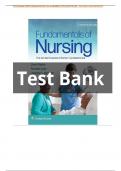Exam (elaborations)
Test Bank for Fundamentals of Nursing 10th Edition by by Carol Taylor, Pamela Lynn & Jennifer L Bartlett, All Chapter 1-47, A+ guide.
Test Bank for Fundamentals of Nursing 10th Edition by by Carol Taylor, Pamela Lynn & Jennifer L Bartlett, All Chapter 1-47, A+ guide.
[Show more]



